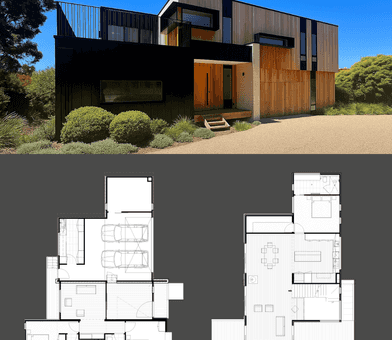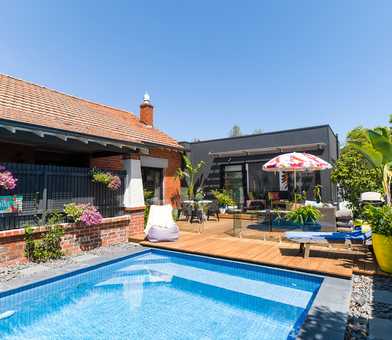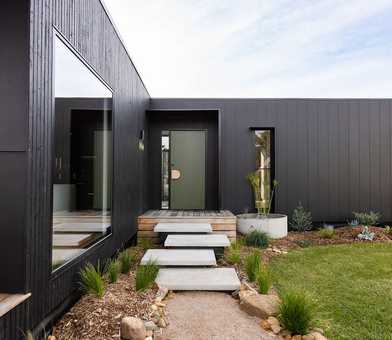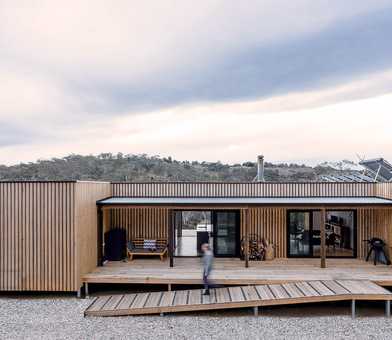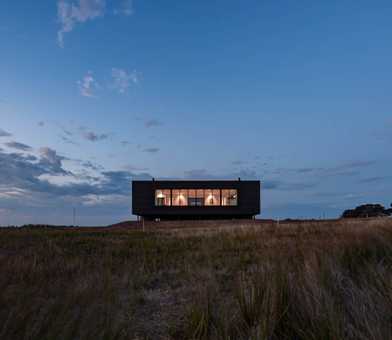In this feature video, we chat with Ashley Beaumont, cofounder of Ecoliv, about the process of obtaining a new prefabricated home. We also talk about the progression of this form of construction over recent years, and how it has become a leading practice in building sustainable homes.
Video Transcript
Leah: Prefabricated housing has come such a long way over the last 10 years. Think about incredible design innovation, sustainability and energy efficiency and you’ve got yourself the most beautiful home on the block. Now this home behind me ticks all of those boxes. Were about to meet the guy who created the whole thing and find out exactly how it’s all put together.
Ashley: My names Ashley Beaumont, myself and my wife Esme started up Ecoliv Buildings about seven years ago and we just focus on sustainability and design and construction. Prefab homes are houses that are built off-site so not on the actual construction site. So we have like a factory or facility where all the homes are built there are totally finished, so they turn up to site all finished, painted, tiles, kitchen installed, the whole thing complete. Then we deliver on site and spend a few weeks swinging upper surfaces and finishing off the house.
Leah: Hi Ashley!
Ashley: Hi Leah, how are you going?
Leah: Great, how are you?
Ashley: Good thanks.
Leah: Nice spot.
Ashley: It’s fantastic, near the beach.
Leah: Yes, not just near, virtually right on top of the beach. But this block as well and sitting on this block, this gorgeous home, I can’t believe that is a prefab.
Ashley: Yeah it is. All pre-built and delivered to site.
Leah: Unbelievable, its huge!
Ashley: Yeah it is, yeah yeah.
Leah: It’s so much bigger than I thought it was going to be and it actually , I mean you know without sounding corny but the idea of sometimes a prefab house, they can look a little [ehh]. This is amazing, it’s so beautiful.
Ashley: Well see its more of a modern way of doing the prefab, definitely evolved over the years. It’s not just your normal sort of predetermined basic buildings. They’re very much designed to suit the modern age and all new products and finishes.
Leah: Yeah right. So how long so the actual build take?
Ashley: Took about 20 weeks in the factory, then we delivered on site. Designed to suit the elements with the sea breezes and the wind and also to try and capture the solar form the back as well, the northern aspect.0
Leah: So it’s really a very much of a considered process.
Ashley: Yeah definitely. Its designed to suit the site and also designed to suit the client’s needs, but also the focus on environmentally sustainable design and construction as well.
Leah: Gosh. When you say sustainable, you know like what are we talking?
Ashley: We are talking about a minimum seven stain rating, double glazing, installation everywhere, water tanks and solitary units or incorporating set designs. So really making the most of the natural environments and using them for the house.
Leah: And a really small footprint as well.
Ashley: Yes definitely. The biggest constraint and challenge when designing instruction in prefab, is not so meeting the transport requirements. Size restrictions on height, length and width, then also considering the delivery phase onto site and what sort of constraints you have in terms of accessibility to the site, powerlines, trees, sloping sites. So they are big sort of problems you have to face. But once you do a bit of research and design and cover that early on, everything seems to flow after that.
Leah: Thank you. Wow! This does not look like the interior of a prefab home.
Ashley: No, definitely not.
Leah: Oh my gosh, it’s so solid and the ceilings are so high and look at these stairs. Oh my gosh, there’s so much to look at, it’s like sensory overload. Can we go up?
Ashely: Yes we can.
Girl: How cool.
Leah: Wow! This is so much bigger than what I was expecting it to be. It’s so open.
Ashley: Yeah it is, so we are making sure we are using all the space, there’s no wasted space in the design.
Leah: None at all. But I’m really surprised at the floors of course, because they’re so solid and not what I was expecting and the ceiling height. This is mind-blowing how this is achievable with a prefabrication.
Ashley: Well yes, it’s all your standard construction methods, it will be a little bit different to the prefab delivery. But the same ceiling heights, same material used for a normal building just all put together more sturdy for transport and delivery day.
Leah: And I love the way that you’ve designed each wall to be like a vista, a picture frame. You’ve got the frame here that gives that gorgeous aspect for out the back, beautiful. This area here, which is your outdoor dining obviously which is just like the most beautiful space. And then the piece de resistance, this section here which is your view over the ocean.
Ashley: The design is to picture frame the views to the south, so when you are sitting in the lounge room you can sit there and look out to the view. The views out to the east and north are rural aspect as well.
Leah: So every area is considered.
Ashely: Yes definitely.
Leah: I really can feel though with those doors open, that is dragging me towards the outdoor dining area. Can we go have a look outside? Is that alright?
Ashley: Yes, let’s go
Ashley: recently we’ve completed a few projects across water, so we’ve had a project in French Island Victoria. We’ve gone across on a barge, five little pieces and delivered on site, put back together. We’ve also sent one across to Tasmania, inside the spirit of Tasmania as well so they’re more difficult components in terms of working in delivery and the design. But also other projects where we’ve done crane lifts installs in the project insights into Melbourne. So a lot of those are just different design elements and different site constraints and delivery methods that really effect the design.
Leah: Oh wow, this is so nice. How beautiful is this, how amazing. Oh my gosh and there’s a swimming pool
Ashley: Yes it is down there. Its tucked away on the eastern side of the house, away from the weather.
Leah: How cool. You’ve thought of everything. What about the challenges? What were your biggest challenges as far as, I mean aesthetically I’m sure you’re going to have certain elements that you need to attend to. But environmentally, you’ve got everything coming at you in this place, you really do on every angle. What was the biggest one you had to consider?
Ashley: Well the biggest thing is obviously capturing the views to the ocean which our loves, which is the reason why we bought the block. But then its facing south, so we get a lot of southwesterly flying through during winter and during summer, with the cooler changes coming through. So having eastern decks, western decks, northern decks so all different spots where you can get away from the elements.
Leah: What about the assembly, was that tricky?
Ashley: No it wasn’t too bad. Once we got our designs sorted out and the engineering sorted out initially then all that flows on delivery day so.
Leah: Yeah right. Like tetris, it all just slots in together.
Ashley: Exactly.
Leah: what about fitting in as far as your design elements concerned with the other houses that are already established
Ashley: A lot of different things happen during the design process, but its really just trying to get an individual look for each house but also being considerate of next door neighbors and surrounds as well which is a little bit of a challenge.
Leah: no doubt. You’d be like the ultimate, constant professional in dealing with people by this stage wouldn’t you
Ashley: Well yeah, you tend to learn a few things over the years so.
Leah: People skills, they’re always good
Ashley: Yeah that’s right.
Ashley: I’ll probably see prefabrication in Australia sort of really advancing in the next 10-15 years and once people start seeing more examples of the work from ourselves and other fabrications, they can see that you’re getting really good quality build. You know I can see it really taking off and being accepted as the mainstream form of construction. Which then will help the environment as well, the construction methods and less wastage during construction of controlled environments, not much sight disturbance
